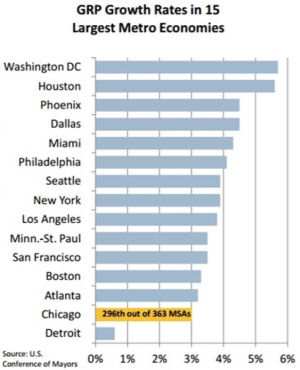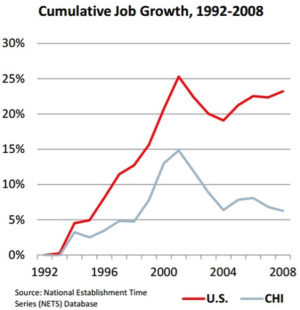Knowledge Exchange Recap: Poverty and the Regional Economy
Each month we’re reporting out on our Knowledge Exchanges, held as part of our Visiting Fellowship in Urban Poverty with Loyola University of Chicago’s Center on Urban Research and Learning (CURL).
In late 2014 a discussion was lead by Frank Beal, Senior Executive, Civic Consulting Alliance, who discussed the relationship between regional economic policy and rates of poverty. The recap below of the session’s conversation is provided courtesy of our Visiting Fellow.

If one examines poverty at the global level, there is a relationship between poverty reduction and economic growth. There is also a relationship between poverty rates and government policies. For example, the relatively low poverty rates in European countries are due, in part, to public investments in the social safety net.
Therefore, it is important to understand how the political and economic sectors work together to either alleviate or exacerbate poverty. The relationship among government, the private economy, and poverty rates can be understood by keeping in mind five key points:
- The government sets the rules about how the “private” economy functions
- The government provides inputs for the “private” economy: education, roads, research, etc.
- The government provides subsidies for the poor: public housing, EITC, food stamps, unemployment insurance, Medicaid, etc.
- The government supports programs designed to get people back into the “private” economy: workforce training, etc.
- The government is a huge employer
Many poverty researchers and policy makers focus on the third point, but it is important to think about how the other points impact BPI’s anti-poverty work. Furthermore, a strong economy is correlated with lower levels of unemployment, and anti-poverty efforts are often thwarted by poorly functioning economies.
Chicago’s regional economy was growing throughout the 1990’s, but since 2000, the regional economy has been lagging—metro Chicago’s economy is not growing at the same rate as other metropolitan areas. In 2010, the State of Illinois ranked 47th in the nation in terms of economic growth. This decline in economic growth is due to several factors. First, Chicago is beginning to suffer from structural issues that have negatively impacted other industrial Midwestern cities, such as the decline of manufacturing jobs and the growth of low wage service jobs. In addition, Illinois has struggled with a fragmented government structure and a history of political corruption.
Discussion Summary
Chicago’s economy may not be growing as fast as other metro areas, but we started off with a relatively stronger economy. Is it possible that other metro areas are just catching up and Chicago’s economy is doing fine?
Chicago may continue to have a better economy than faster growing metros, but our lack of growth is problematic because we have higher rates of unemployment than we did 10 years ago. Without a growing economy, it will be more difficult to recover from the recession, and this means more families are likely to end up living at or near the poverty line. Furthermore, without a strong economy, Chicago will not attract new residents. Chicago’s population growth and economic growth are linked. Prior to the recession, Chicago’s economic opportunities drew people from neighboring states. That in-migration has slowed, and the City of Chicago is losing population, despite a steady influx of immigrants.
What can be done to improve the regional economy?

The most effective economic development is done on a regional, rather than a municipal, level. World Business Chicago is an example of a regional public-private partnership designed to spark regional economic growth by increasing exports; further developing Chicago’s advanced manufacturing, transportation and logistics sectors; and investing in infrastructure.
Regional planning can be challenging due to the size of the Chicago metropolitan area. Furthermore, the large number of suburban municipalities and the multiple layers of government can make coordination difficult. However, there has been good political leadership in this area – Toni Preckwinkle and Mayor Emmanuel have been thinking creatively about regional strategies.
Further Reading and Additional Resources
Restoring Chicago’s Momentum: A Regional Agenda for Economic Growth Metropolis Strategies: http://www.metropolisstrategies.org/documents/RegionalEconomyReport.pdf
Rank, Yoon, and Hirschl. 2003. “American Poverty as a Structural Failing: Evidence and Arguments,” Journal of Sociology and Social Welfare.
Turner, Margery Austin, Peter Edelman, Erika Poethig, and Lauden Aron. 2014. Tacking Persistent Poverty in Distressed Urban Neighborhoods, Urban Institute White Paper. http://www.urban.org/UploadedPDF/413179-Tackling-Persistent-Poverty-in-Distressed-Urban-Neighborhoods.pdf
Back To Blog